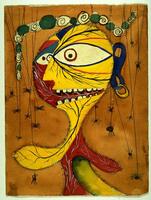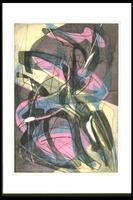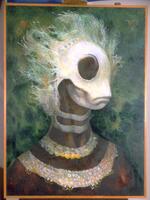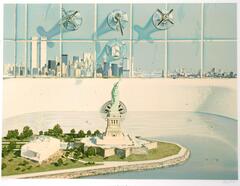If you are unable to come to UMMA in person due to illness, quarantine, etc., you can choose a work from this set of surrealist and surrealist-adjacent pieces from the UMMA collection.
59 Items in this Learning Collection
Collection Object
Collection Object
Collection Object
Collection Object
Collection Object
Collection Object
Collection Object
Collection Object
Collection Object
Collection Object
Collection Object
Collection Object
Collection Object
Collection Object
Collection Object
Collection Object
Collection Object
Collection Object
Collection Object
Collection Object
Collection Object
Collection Object
Collection Object
Collection Object
Collection Object
Collection Object
Collection Object
Collection Object
Collection Object
Collection Object
Collection Object
Collection Object
Collection Object
Collection Object
Collection Object
Collection Object
Collection Object
Collection Object
Collection Object
Collection Object
Collection Object
Collection Object
Collection Object
Collection Object
Collection Object
Collection Object
Collection Object
Collection Object
Collection Object
Collection Object
Collection Object
Copyright
All Rights Reserved
()
Quetzal
Accession Number
1947/2.12
Title
Quetzal
Artist(s)
Wifredo Lam
Artist Nationality
Cuban
Object Creation Date
1947
Medium & Support
lithograph on paper
Dimensions
16 1/2 in x 13 in (41.9 cm x 33 cm);16 1/2 in x 13 in (41.91 cm x 33.02 cm);28 1/8 in x 22 1/8 in (71.44 cm x 56.2 cm);22 1/8 in x 18 1/8 in (56.2 cm x 46 cm)
Credit Line
Museum Purchase
Label copy
The Brunidor Portfolio No. One
At the request of art critic Nicholas Calas, seven Surrealist artists collaborated on a print portfolio published by Brunidor Editions, in New York, whose director was Robert Altmann. The artists were Max Ernst, Stanley William Hayter, Wifredo Lam, Matta, Joan Miró, Kurt Seligmann, and Yves Tanguy. The etchings were printed in Hayter’s Atelier 17, while the lithographs were pulled in the studio of Alfred Jones.
Calas’ introduction to the portfolio turned on the age-old controversy between line and color, in which line or form is seen as relating to thought, while color or light is considered pertinent to emotion. Excerpts from his essay, entitled "Saper Vedere" (To Know How to See), are given in italics in the labels accompanying each of the prints from the portfolio, all of which are exhibited here. Calas describes not only what these artists "see" with their imaginations, but also what he as a critic "sees" as he interprets the inherent meanings of these prints.
University of Michigan Museum of Art director Jean Paul Slusser in 1947 showed himself to be in the vanguard of contemporary trends in his recommendation that this portfolio be acquired in the very year it was published.
In Lam . . . the appeal is in a lode-image carrying us to the very sources of totemism, recalled in premonition of changes which, out of contraries meeting to find their own destruction, will mould a new existence. One needs serpent optics to gaze at Lam’s jungle god.
Of multicultural heritage (Chinese father and black Cuban mother), Lam created a richly syncretistic art. The Surrealists, many of whom he met in 1940 in Marseilles, valued his work highly. Breton declared that " . . . of all the artists I know, [Lam] is the one who seems to me to have the most to say." The frighteningly aggressive figure in his plate for The Brunidor Portfolio is entitled Quetzal, the Aztec name of a bird native to Central America, which figures in the image of the Aztec feathered serpent divinity. However, according to Brunidor Editions director Robert Altmann, the lithograph actually represents figures from Afro-Cuban mythology.
Label copy from exhibition "Dreamscapes: The Surrealist Impulse," August 22 - October 25, 1998
Subject matter
This print is part of a portfolio published by Brunidor Editions, New York,the portfolio's namesake, at the request of art critic Nicholas Calas. The portfolio includes seven prints from a number of prominent Surrealist artists, including: Max Ernst, Joan Miró, Stanley William Hayter, Roberto Matta, Kurt Seligmann, and Yves Tanguy. Calas’ introduction to the portfolio turned on the age-old controversy between line and color, in which line or form is seen as relating to thought, while color or light is considered pertinent to emotion. Calas describes not only what these artists "see" with their imaginations, but also what he, as a critic, "sees" as he interprets the inherent meanings of these prints.
Lam's contribution, plate three of seven, has a Surrealist view of the Central American bird, praised by the ancient Mayans, the Quetzal. The Cuban artist created this work during a brief stay in New York. In his typical cubist style, this work brings together the native American imagery with a modernist take on the theme.
Physical Description
This color lithograph has a bright yellow background with figures in red and white at the center. Horizontally oriented at the center is a large white semi-geometric creature with three heads—one at the bottom and two at the flanks—that is capped with horns and breasts. There is a red box-like figure in the background that has a horned head and a series of horns, wings, and flames emanating from it. The print is numbered, titled and signed (l.r.) in pencil: "no 57 - "Quetzal" / Wilfredo Lam".
Primary Object Classification
Print
Collection Area
Modern and Contemporary
Rights
If you are interested in using an image for a publication, please visit http://umma.umich.edu/request-image for more information and to fill out the online Image Rights and Reproductions Request Form.
Keywords
Cuban
Cubist
Surrealism
Trogoniformes (order)
modern and contemporary art
symbols
totems
1947/2.12
Title
Quetzal
Artist(s)
Wifredo Lam
Artist Nationality
Cuban
Object Creation Date
1947
Medium & Support
lithograph on paper
Dimensions
16 1/2 in x 13 in (41.9 cm x 33 cm);16 1/2 in x 13 in (41.91 cm x 33.02 cm);28 1/8 in x 22 1/8 in (71.44 cm x 56.2 cm);22 1/8 in x 18 1/8 in (56.2 cm x 46 cm)
Credit Line
Museum Purchase
Label copy
The Brunidor Portfolio No. One
At the request of art critic Nicholas Calas, seven Surrealist artists collaborated on a print portfolio published by Brunidor Editions, in New York, whose director was Robert Altmann. The artists were Max Ernst, Stanley William Hayter, Wifredo Lam, Matta, Joan Miró, Kurt Seligmann, and Yves Tanguy. The etchings were printed in Hayter’s Atelier 17, while the lithographs were pulled in the studio of Alfred Jones.
Calas’ introduction to the portfolio turned on the age-old controversy between line and color, in which line or form is seen as relating to thought, while color or light is considered pertinent to emotion. Excerpts from his essay, entitled "Saper Vedere" (To Know How to See), are given in italics in the labels accompanying each of the prints from the portfolio, all of which are exhibited here. Calas describes not only what these artists "see" with their imaginations, but also what he as a critic "sees" as he interprets the inherent meanings of these prints.
University of Michigan Museum of Art director Jean Paul Slusser in 1947 showed himself to be in the vanguard of contemporary trends in his recommendation that this portfolio be acquired in the very year it was published.
In Lam . . . the appeal is in a lode-image carrying us to the very sources of totemism, recalled in premonition of changes which, out of contraries meeting to find their own destruction, will mould a new existence. One needs serpent optics to gaze at Lam’s jungle god.
Of multicultural heritage (Chinese father and black Cuban mother), Lam created a richly syncretistic art. The Surrealists, many of whom he met in 1940 in Marseilles, valued his work highly. Breton declared that " . . . of all the artists I know, [Lam] is the one who seems to me to have the most to say." The frighteningly aggressive figure in his plate for The Brunidor Portfolio is entitled Quetzal, the Aztec name of a bird native to Central America, which figures in the image of the Aztec feathered serpent divinity. However, according to Brunidor Editions director Robert Altmann, the lithograph actually represents figures from Afro-Cuban mythology.
Label copy from exhibition "Dreamscapes: The Surrealist Impulse," August 22 - October 25, 1998
Subject matter
This print is part of a portfolio published by Brunidor Editions, New York,the portfolio's namesake, at the request of art critic Nicholas Calas. The portfolio includes seven prints from a number of prominent Surrealist artists, including: Max Ernst, Joan Miró, Stanley William Hayter, Roberto Matta, Kurt Seligmann, and Yves Tanguy. Calas’ introduction to the portfolio turned on the age-old controversy between line and color, in which line or form is seen as relating to thought, while color or light is considered pertinent to emotion. Calas describes not only what these artists "see" with their imaginations, but also what he, as a critic, "sees" as he interprets the inherent meanings of these prints.
Lam's contribution, plate three of seven, has a Surrealist view of the Central American bird, praised by the ancient Mayans, the Quetzal. The Cuban artist created this work during a brief stay in New York. In his typical cubist style, this work brings together the native American imagery with a modernist take on the theme.
Physical Description
This color lithograph has a bright yellow background with figures in red and white at the center. Horizontally oriented at the center is a large white semi-geometric creature with three heads—one at the bottom and two at the flanks—that is capped with horns and breasts. There is a red box-like figure in the background that has a horned head and a series of horns, wings, and flames emanating from it. The print is numbered, titled and signed (l.r.) in pencil: "no 57 - "Quetzal" / Wilfredo Lam".
Primary Object Classification
Collection Area
Modern and Contemporary
Rights
If you are interested in using an image for a publication, please visit http://umma.umich.edu/request-image for more information and to fill out the online Image Rights and Reproductions Request Form.
Keywords
Cuban
Cubist
Surrealism
Trogoniformes (order)
modern and contemporary art
symbols
totems
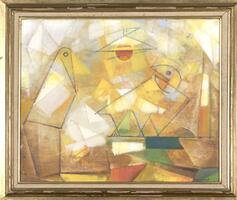
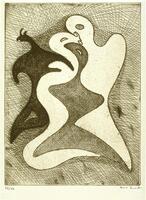
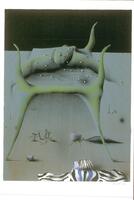
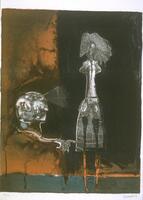

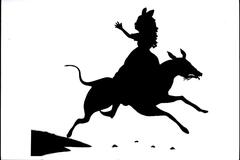

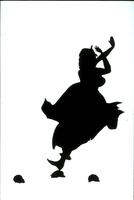

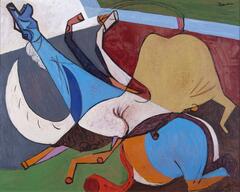
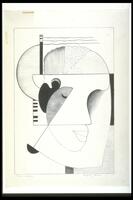
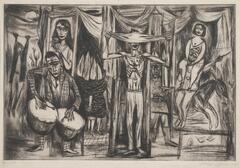

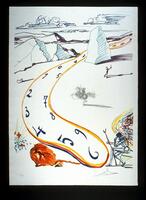
![In this mixed-media print, there is a white background with black outlines of facial features, lips and an eye, and a creature in the bottom left. In the upper left corner there is a rectanglular sheet in cream layered on top; a wavy vertical design stretches diagonally from the top of the rectangle to the bottom in yellow, red, and blue. Within this sheet, there are small figures at the center left drawn in black. To the right in the sheet, there is a collaged image of one of the artist's paintings, incorporated into a cube. Above, there are drawn birds. There is a small mechanical-like figure on the sheet at the bottom left. At the center of the print, in the cream page, the artist signed "Dali" and dated the print "1975. To the bottom left, on the larger white page, there is text inscribed in the plate, mirrored and someone illegible, that possibly reads "Leill Ciclopeer Alucire la bouche Almient tire / Lula [illegible]." The print is number at the lower left in pencil. In this mixed-media print, there is a white background with black outlines of facial features, lips and an eye, and a creature in the bottom left. In the upper left corner there is a rectanglular sheet in cream layered on top; a wavy vertical design stretches diagonally from the top of the rectangle to the bottom in yellow, red, and blue. Within this sheet, there are small figures at the center left drawn in black. To the right in the sheet, there is a collaged image of one of the artist's paintings, incorporated into a cube. Above, there are drawn birds. There is a small mechanical-like figure on the sheet at the bottom left. At the center of the print, in the cream page, the artist signed "Dali" and dated the print "1975. To the bottom left, on the larger white page, there is text inscribed in the plate, mirrored and someone illegible, that possibly reads "Leill Ciclopeer Alucire la bouche Almient tire / Lula [illegible]." The print is number at the lower left in pencil.](/media/W1siZiIsIjIwMjIvMDUvMjUvMWUwenVmM3Nlel9kZWZhdWx0LmpwZyJdLFsicCIsInRodW1iIiwiMjQweDIwMCJdXQ?sha=03c3865ec6fdec9d)
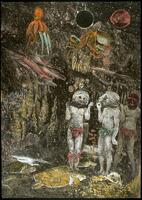
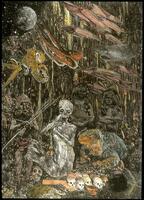
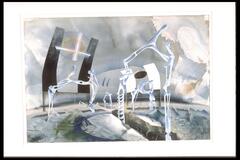
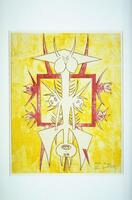

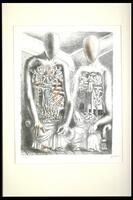

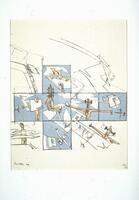
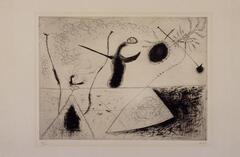
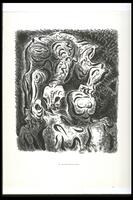
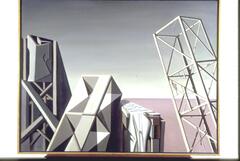

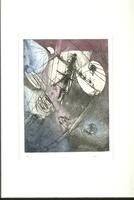


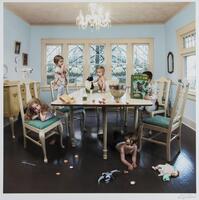
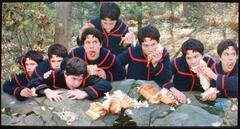
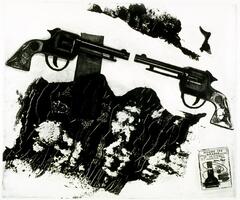
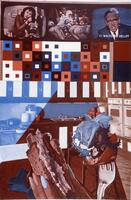
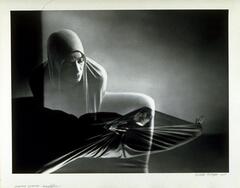
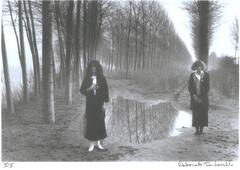

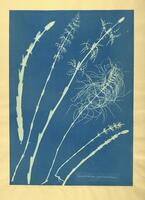
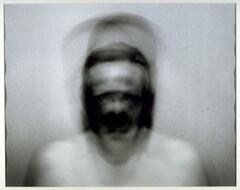
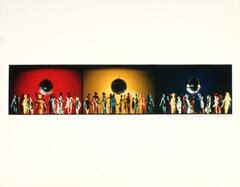


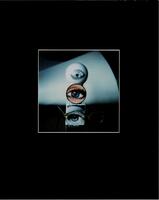

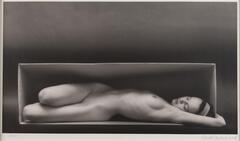
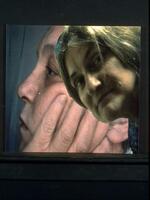
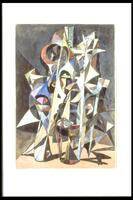
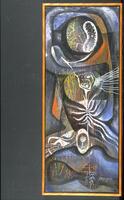
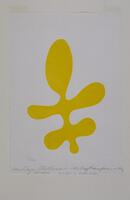

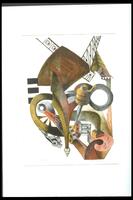
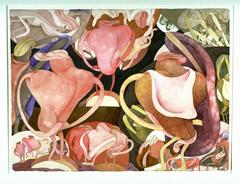
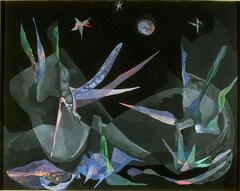

![A clear glass bubble rests on the bowl of a plain white clay pipe. Along the stem of the pipe are the words, "Ce que [sic] manque à nous tous." A clear glass bubble rests on the bowl of a plain white clay pipe. Along the stem of the pipe are the words, "Ce que [sic] manque à nous tous."](/media/W1siZiIsIjIwMjIvMDkvMjQvMmR5MHViN2o5Yl9kZWZhdWx0LmpwZyJdLFsicCIsInRodW1iIiwiMjQweDIwMCJdXQ?sha=e23a50659ff4d560)
